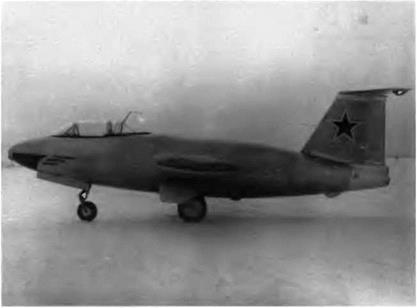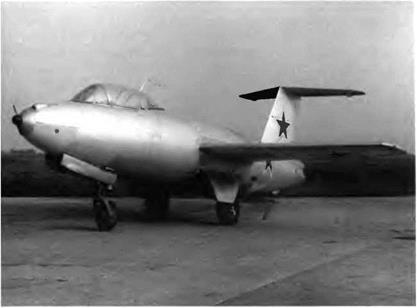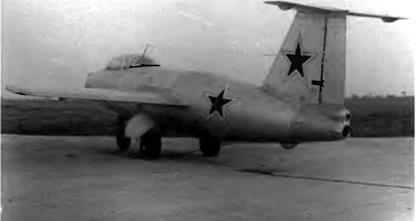1-270 / Zh
In the history of aviation transitional periods are always marked by attempts to develop more powerful engines The first turbojets offered only meager thrust. For example, the first Soviet jet—the TR-1, designed and built by A. M Lyulka—delivered power equivalent to 1,323 daN (1,250 kg st) and was not available until 1947. The wartime German jets Jumo 004 and BMW 003 had thrusts limited to 880 and 785 daN (900 and 800 kg st) respectively Therefore, during this transitional period several aircraft manufacturers including Mikoyan and Guryevich decided to test the efficiency of rocket engines or ZhRD (Zhidkostniy Raketniy Dvigatyel liquid-propellant rocket engine) for a new type of high-speed, high-altitude interceptor At that time, only the rocket engine could meet those two requirements One of the basic advantages of rocket engines is that their thrust is slightly subordinated to speed and altitude, two values that then depended only on the amount of combustible and oxidizer the interceptor could carry in its tanks.
The first thing that catches one’s eye about the three-view drawing of the Zh is the T-tail (the stabilizer is on top of the fin). In a note dated 30 May 1946 that was included with the preliminary design, Mikoyan and Guryevich wrote "If one reduces the effect of the wing on the stabilizer, it may be supposed that the moment characteristics will not be modified up to Mach 0 9 This is why the stabilizer has been moved upward, in relation to the wing, this displacement is equal to 1 2 MAC (mean aerodynamic chord).” Similar high-set stabilizers would appear later on transonic aircraft such as the MiG-15, MiG-17, and 1-320 But in 1946 TsAGI had not yet studied the characteristics of swept-wing aircraft, and manufacturers were not yet equipped with the necessary experimental and scientific facilities. This is why both 1-270 prototypes built at the end of 1946 had a straight wing The sweep angle at the leading edge was 12 degrees. Only the stabilizer was swept back (30 degrees at the leading edge) as shown in the preliminary design.
The 1-270 was an all-metal aircraft with a circular semimonocoque fuselage and a cantilever midwing. The fuselage was built in two parts and then mated (a first for MiG), The one-piece wing had a five-spar box structure and thick skin panels and was embedded in the lower part of the fuselage Its laminar flow airfoil was relatively thm The preliminary design called for a wing with a 20-degree quarter-chord sweep angle identical to that of the MiG-8, but as noted both prototypes received a straight wing with a modest taper to both the leading and trailing edge The main gear had a very narrow wheel track (1.6 m
|
|
The first prototype of the 1-270, or Zh-1, made its First flight without its power plant, towed behind a Tu-2 It was then released and allowed to glide to a landing.
|
|
The Zh-1 was somewhat short-lived Test pilot Yuganov had to make a belly landing, and the aircraft was thought to be beyond repair.
|

[5 feet, 3 inches]) and retracted inward into the wing center section The nose gear well and the two 23-mm NS-23 cannons (40 rpg) were located under the pressurized cockpit
It was planned to put two rocket pods (four RS-82s each) under the wing, but the idea was not accepted. The seat was equipped with a small pyrotechnic device to enable the pilot to eject in case of emergency. The power plant was a dual-chamber RD-2M-3V bipropellant rocket engine dev eloped by L S Dushkm and V P Glushko The combined thrust of both chambers was 1,421 daN (1,450 kg st)—that is, 1,029 daN (1,050 kg st) for the mam chamber and 392 daN (400 kg st) for the cruise chamber mounted on top The rocket engine was pump – fed by a mixture of nitric acid, kerosene, and hydrogen peroxide (80 percent). The propellants weighed 2,120 kg (4,672 pounds). All propellants were stored in three sets of tanks 1,620 kg (3,570 pounds) of nitric acid in four tanks, 440 kg (970 pounds) of kerosene in one tank, and 60 kg (132 pounds) of hydrogen peroxide in seven tanks The propellant turbopumps were driven by two generators one that was part of the aircraft’s electrical system; and a second, powered by the wind – milling action of a small propeller in the nose, that served as a backup The first prototype or Zh-1 was rolled out at the end of 1946 without its power plant and made a few flights in December 1946 towed behind a Tu-2 bomber During these tests the bomber released it, and it glided to landings Before these first glide descents, pilots trained on a modified Yak-9 fighter that was weighted with lead ingots to approximate the design yaw and pitch characteristics of the 1-270 The RD-2M – 3V rocket engine was mounted on the second prototype or Zh-2. In early 1947 an OKB test pilot, V. N Yuganov, used the engine in flight. He handed responsibility for the test flights over to a military pilot, A, K. Pakhomov, who shortly thereafter botched a landing and destroyed the aircraft. Within weeks Yuganov belly-landed the Zh-1, and the prototype was not repaired The 1-270 never made it past its factory tests And with the MiG-9, the Yak-15, and the first surface-to-air missiles in operation, the rocket-powered interceptor was no longer essential to the air defense forces So work came to a halt on the 1-270 and the RM-1, a similar type of interceptor designed by A S Moskalyev
Specifications
Span, 7 75 m (25 ft 5 1 in); length, 8 915 m (29 ft 3 in); height, 3 08 m (10 ft 1 3 in), height in level flight position, 2 58 m (8 ft 5 6 in), wheel track, 1.6 m (5 ft 3 in); wheel base, 2.415 m (7 ft 11 10 in), wing area, 12 m2 (129 2 sq ft), empty weight, 1,546 kg (3,407 lb); takeoff weight, 4,120 kg (9,080 lb), propellants, 2,120 kg (4,672 lb), wing loading, 343.3 kg/m2 (70 4 lb/sq ft).
|
|
The second prototype of the 1-270 or Zh-2, had a standby electrical system that was powered by the windmilling action of the small propeller in its nose
|
|
■
This photograph of the Zh-2 shows the two superimposed chambers of the RD-2M-3V rocket engine.
Performance
Max speed, 900 km/h at 5,000 m (486 kt at 16,400 ft), 928 km/h at 10,000 m (501 kt at 32,800 ft), 936 km/h at 15,000 m (505 kt at 49,200 ft), climb to 10,000 m (33,800 ft) in 2.37 min; to 15,000 m (49,200 ft) in 3.03 min; service ceiling, 17,000 m (55,760 ft), landing speed 137 km/h (74 kt); takeoff roll, 895 m (2,935 ft); landing roll, 493 m (1,617 ft); endurance with both chambers, 255 sec; with the cruise chamber only, 543 sec.














